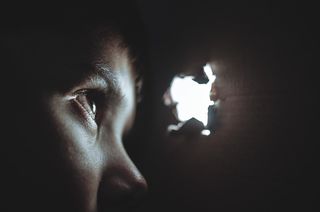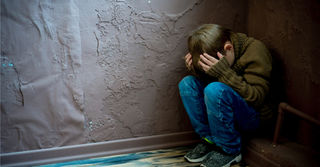Punishment
The Psychology of Child Torture
What is the common nature of these horrific acts — and the people behind them?
Posted January 18, 2018 Reviewed by Ekua Hagan
David Allen Turpin, 57, and Louise Anna Turpin, 49, from Perris, California, face charges of torture and child endangerment after holding their 13 children captive.
Authorities found some of their kids chained to beds, "in dark and foul-smelling surroundings," following an emergency phone call from the 17-year-old daughter who escaped from the house on Sunday.

The dirty and emaciated children are said to have been forced to memorize passages of the Bible during “very strict” homeschooling sessions.
The gathering evidence raises the specter of an extreme form of child abuse amounting to child torture. What is the motivation behind perpetrators of this kind of extreme crime? What is likely to be the kind of torture that these children experienced? Might they be too traumatized to give a clear account themselves, at least in the immediate future?
Perhaps some possible answers may be revealed by research into this phenomenon, including a case series of 28 children in the United States suffering from physical abuse, neglect, torture, and psychological maltreatment, such as terrorizing and isolation.
Entitled "Child Torture as a Form of Child Abuse," the study includes cases in which children were given caustic substances as “punishment food”; so deprived of water they were forced to drink from the toilet; chronically starved, with all access to food in the house locked away; strangled until unconscious and stabbed with a knife; and struck over the head with metal objects and baseball bats.
The study, published in 2014 in the Journal of Child and Adolescent Trauma, found that 36 percent of these children died as a result of their abuse, and the torture could last for up to eight years.
The authors of the study argue that torture contrasts with other forms of child abuse, which usually result from episodic unchecked anger or a loss of self-control in a person in charge of a child. Torture is more prolonged and designed to establish domination and control over a child’s psyche. Torture is carried out to physically and psychologically "break" someone. It is estimated that 1 to 2 percent of children being evaluated for abuse in the U.S. in fact represent cases of torture: 93 percent of children were beaten; 21 percent had fractures; 89 percent were extremely isolated; 61 percent were physically restrained; and 89 percent were restricted from food or water. Further, specific threats of death were made to 32 percent, and nearly all the children were medically neglected, yet half had a history of prior referrals to child protection services.
One 14-year-old investigated in this research reported being forced to eat roaches, spiders, and other insects as a form of punishment, including an attempt by the family to force-feed her a dead mouse. Her father bound her hands behind her back, taped plastic bags over her head and torso, and threatened to drown her.
The authors of the study — Barbara Knox, Suzanne Starling, Kenneth Feldman, Nancy Kellogg, Lori Frasier, and Suzanna Tiapula — point out that the social isolation of the children contributes significantly to the circumstances facilitating torture: 89 percent had been isolated from people outside the immediate family; and 75 percent even experienced solitary confinement. This social isolation typically involved preventing the child from attending school or day care. The isolation was accompanied by an escalation of physically abusive events.
Unlike other abusers, most perpetrators of torture partially confessed to their crimes; however, they significantly minimized or rationalized their individual involvement.
This study, by authors based at the University of Wisconsin School of Medicine and Public Health, Eastern Virginia Medical School, University of Washington, University of Texas Health Science Center at San Antonio, University of Utah, and the National Center for Prosecution of Child Abuse, found that abusers demonstrated little or no remorse. Instead, most perpetrators blamed their victims for precipitating the abuse, using the explanation of necessary discipline and corporal punishment to justify their abusive acts. Commonly, such perpetrators see a religious duty to discipline their children harshly, a particular finding that resonates with the current case in the media spotlight.
In a study called "Invisible Children," the Committee on Child Abuse and Neglect (CCAN) of the North Carolina Pediatric Society investigated whether some child victims escape attention because they are homeschooled.
The investigation found that the North Carolina Division of Non-Public Education (DNPE) had six staff members, three of whom were clerical, yet it was responsible for monitoring 45,000 home schools, with an estimated 80,000 students.
In any given year, the authors found, contact is made with approximately 300 families, but this does not involve a visit to the home school or the home by the DNPE. These 300 families constitute less than 1 percent of registered home schools in North Carolina, and according to this study, published in the North Carolina Medical Journal in 2013, no one on the staff had physically been to the home of a homeschooled child to conduct a home visit as part of the monitoring process since the year 2000.
The authors of this study argue that child maltreatment can present under the pretext of homeschooling, but they also concede that inappropriately connecting child abuse with homeschooling may lead to discrimination, infringement of parental rights, and invasion of privacy. Children in the mainstream school setting are abused, too, and that abuse may also go undetected.
However, homeschooling may be a signal that parents hold profoundly different views than the rest of society about how children should be educated. One possibility is that some will have more authoritarian views, leading to more violence when disciplining or controlling children.
According to a study published in 2002 in the journal Aggressive Behaviour, school corporal punishment was banned in 27 U.S. states, but permitted in 23. Southern states were overrepresented among the permitting states, and Northeast states among those prohibiting. (Since the paper was published, more states have banned corporal punishment.) This study, "School Shooting Fatalities and School Corporal Punishment: A Look at the States," examined the association between student deaths from school shootings across 50 states according to the state’s policy on corporal punishment in schools. The author, Doreen Arcus of the University of Massachusetts-Lowell, found that there were significantly more school shooting deaths in states allowing school corporal punishment compared with those that do not. Also, the rate of school corporal punishment was moderately correlated with the rate of fatal school shootings.
The author concluded that endorsement of school corporal punishment reflects a set of values that are punitive in nature and create a context conducive to the violence that characterizes school shootings.

Child torture arises within a wider context, where rearing children is done through control. Control becomes vital if, for example, you have unusual beliefs that are likely to be challenged or diluted by a child’s contact with the external world. You might become paranoid that the child is not adhering closely to your doctrine.
Extreme violence perpetrated through torture is not about an impulsive, temporary loss of control in a caregiver, but more about a whole child-rearing philosophy — one which is further along a spectrum of what are already widely held views in certain parts of the U.S.
References
School Shooting Fatalities and School Corporal Punishment: A Look at the States. Doreen Arcus. AGGRESSIVE BEHAVIOR Volume 28, pages 173–183 (2002)
Invisible Children. Meggan Goodpasture, V. Denise Everett, Martha Gagliano, Aditee P. Narayan, Sara Sinal. North Carolina Medical Journal. 2013;74(1):90-94
Child Torture as a Form of Child Abuse Barbara L. Knox & Suzanne P. Starling & Kenneth W. Feldman & Nancy D. Kellogg & Lori D. Frasier & Suzanna L. Tiapula. Journal of Child & Adolescent Trauma March 2014, Volume 7, Issue 1, pp 37–49




